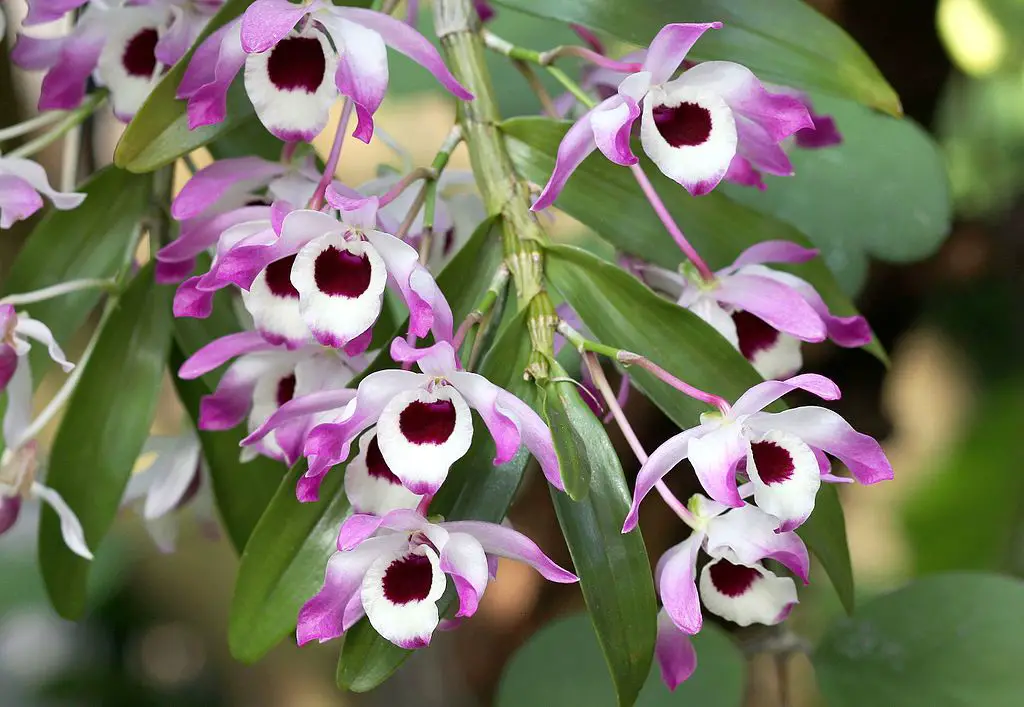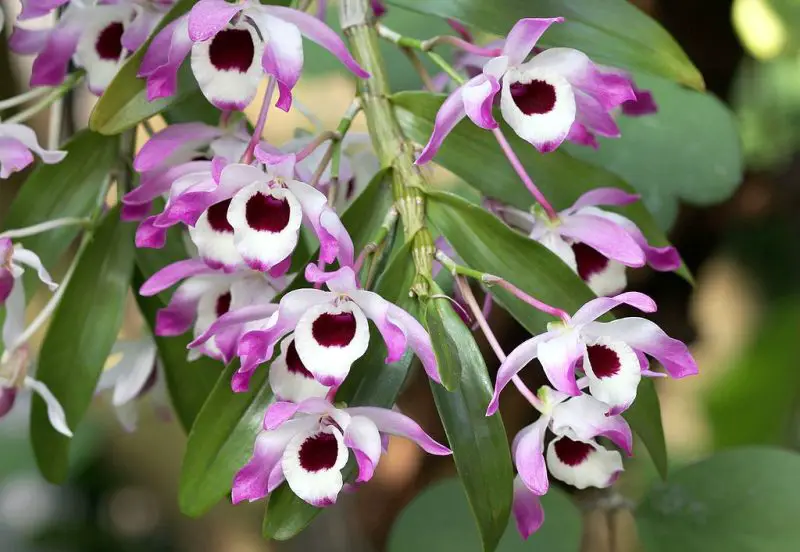
Dive into Dendrobium Orchid Care for a thriving bloom display. Expert tips on light, watering, and feeding, all in one essential guide!
Dendrobium Orchid Care Key Takeaways:
Step into the world of Dendrobium Orchid Care and discover the joy of nurturing these radiant blooms.
With our straightforward tips, you’ll unlock the secrets to vibrant flowers and robust health, transforming your space with their exotic allure.
 4 Live Orchid Plants to Choose (Dendrobiums)
4 Live Orchid Plants to Choose (Dendrobiums)
Introduction: The Diverse World of Dendrobium Orchids

Dendrobium orchids are a fascinating and diverse group within the orchid family.
With over 1,800 species, they offer a stunning variety of colors, shapes, and sizes.
These orchids are not only admired for their beauty but also their cultural and medicinal significance.
In this introduction, we’ll explore the world of Dendrobium orchids, from their botanical characteristics to their place in traditional medicine and decoration.
Overview of the Dendrobium Genus
Dendrobium is one of the largest genera in the orchid family. These orchids are native to Asia, Australia, and the Pacific Islands.
They can be found in diverse habitats, from tropical rainforests to mountainous regions.
Dendrobium orchids are known for their long-lasting flowers and are popular among orchid enthusiasts.
Popularity and Uses in Traditional Medicine and Decoration
Dendrobium orchids have a long history of use in traditional medicine, particularly in Asia.
Some species are used in herbal remedies for their supposed health benefits.
In addition to their medicinal uses, Dendrobium orchids are widely used in floral arrangements and decorations for their striking appearance.
Understanding Dendrobium Orchids
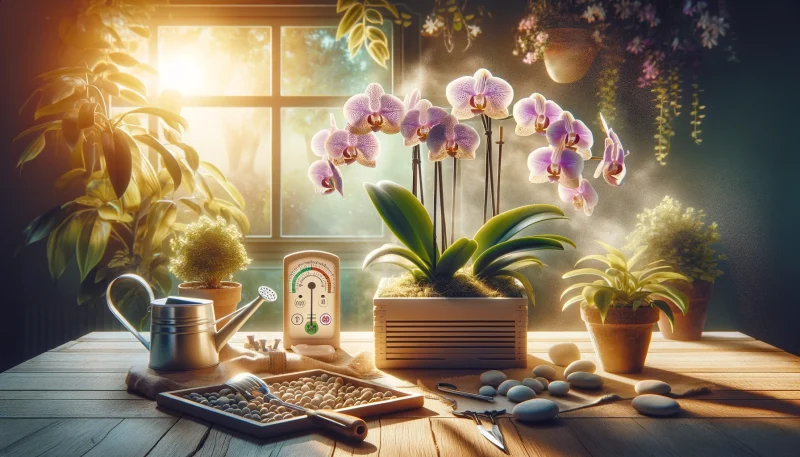
Dendrobium orchids are a diverse and widespread group within the orchid family.
With over 1,800 species, they exhibit a wide range of characteristics that make them both fascinating and challenging to grow.
In this section, we’ll delve into the description and characteristics of Dendrobium orchids, as well as explore the different types that are popular among enthusiasts.
Description and Characteristics
Dendrobium orchids are primarily epiphytes, meaning they grow on other plants, but some are lithophytes, growing on rocks.
They have a sympodial growth habit, with pseudobulbs that vary in size and shape, depending on the species.
The leaves can be deciduous or evergreen, and the flowers are usually produced on a raceme, with colors ranging from white to pink, purple, and yellow.
Different Types of Dendrobium Orchids
Dendrobium Morning Glory 3″ Pot
There are several types of Dendrobium orchids, each with its own unique characteristics and care requirements:
- Phalaenopsis-type Dendrobiums: These are evergreen orchids with long, arching stems and large, showy flowers. They are one of the most popular types for indoor cultivation.
- Dendrobium nobile: Known for their vibrant colors and distinct fragrance, these orchids produce flowers along the length of their cane-like pseudobulbs.
- Den. kingianum: A compact and hardy species, often called the pink rock orchid, which is suitable for cooler climates.
Each type of Dendrobium orchid has its own specific needs in terms of light, temperature, and watering, so it’s important to research the particular species you are growing.
Ideal Growing Conditions for Dendrobium Orchids
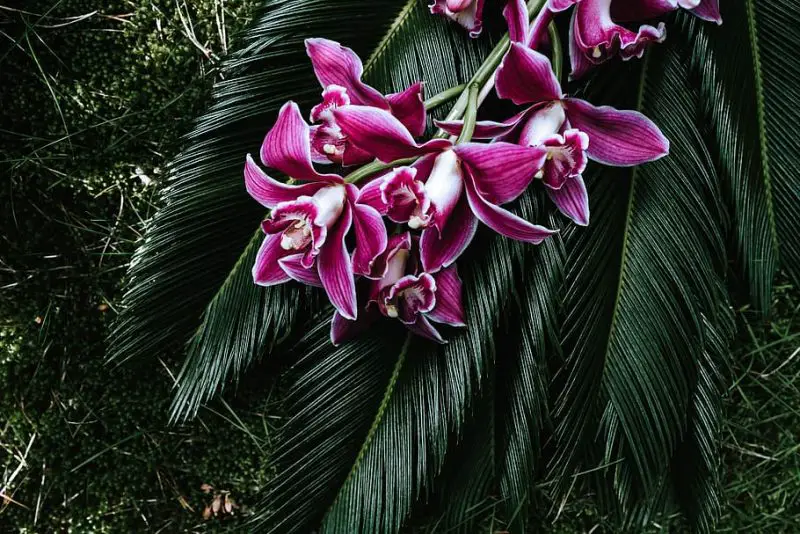
Dendrobium orchids thrive under specific conditions that mimic their natural habitat.
By providing the right environment, you can ensure healthy growth and beautiful blooms.
Let’s explore the ideal growing conditions for these orchids.
Light: Bright and Filtered
- Dendrobium orchids prefer bright, indirect light. An east-facing window or a spot with filtered morning sun is ideal.
- Protect the orchids from direct afternoon sunlight, which can cause leaf burn. Use sheer curtains or a shade cloth to diffuse the light.
Temperature: Warm Days, Cool Nights
- Daytime temperatures should range between 65-75°F (18-24°C) for optimal growth.
- Cooler night temperatures, around 55-60°F (13-15°C), are beneficial for flower development. This temperature drop is crucial for inducing blooming in many Dendrobium species.
Humidity: Consistently Moist Air
- Maintain humidity levels between 50-70% to keep your Dendrobium orchids happy.
- This can be achieved by using a humidifier, placing a tray of water near the plants, or grouping plants together to create a microclimate.
Watering: Regular and Thorough
- Water your Dendrobium orchids once a week, allowing the potting mix to dry slightly between waterings. This mimics the natural rainfall patterns they would experience in their native habitat.
- Ensure good drainage to prevent root rot. Orchids should never sit in stagnant water.
By providing these ideal growing conditions, your Dendrobium orchids will have the best chance to thrive and display their stunning flowers.
Potting and Soil Requirements for Dendrobium Orchids

The right potting environment is crucial for the health and growth of Dendrobium orchids.
These orchids have specific requirements when it comes to pots and soil, which are essential for their well-being.
Choosing the Right Pot
- Dendrobium orchids can be grown in various types of pots, including plastic, terracotta, and specialized orchid pots with extra drainage holes.
- The pot size should be just large enough to accommodate the roots and provide some room for growth. Overly large pots can lead to excess moisture retention and root rot.
- Good drainage is essential. Make sure the pot has drainage holes at the bottom to allow excess water to escape.
Potting Mix for Dendrobium Orchids
- A well-draining potting mix is crucial for Dendrobium orchids. They do not grow in regular potting soil. Instead, use a mix specifically designed for orchids, which typically contains bark, perlite, and charcoal.
- The potting mix should retain some moisture while allowing air to reach the roots. Orchid bark or a blend of bark and other airy materials like sphagnum moss and perlite works well.
- Repotting every 2-3 years or when the potting mix breaks down is important to maintain healthy root growth. Old, decomposed potting mix can retain too much moisture and lead to root problems.
By providing the right pot and soil conditions, you can ensure that your Dendrobium orchids have a strong foundation for healthy growth.
Fertilizing Dendrobium Orchids
Proper fertilization is key to promoting healthy growth and vibrant blooms in Dendrobium orchids. During the growing season, these orchids benefit from regular feeding to support their development.
Regular Fertilization During the Growing Season
- Fertilize Dendrobium orchids every two weeks during the active growing season, typically from spring to early fall.
- Reduce fertilization to once a month during the dormant period in the late fall and winter when the orchid’s growth slows down.
- It’s important to water the orchids thoroughly before applying fertilizer to prevent root burn.
Types of Fertilizers Suitable for Dendrobium Orchids
- Use a balanced orchid fertilizer with an N-P-K ratio of 20-20-20 or similar. This provides the orchid with a balanced mix of essential nutrients.
- Alternatively, you can use a high-nitrogen fertilizer (such as 30-10-10) in the spring and switch to a bloom booster (such as 10-30-20) in the late summer to encourage flowering.
- Always dilute the fertilizer to half the recommended strength to avoid overfeeding, which can harm the orchid.
For more detailed information on fertilizing Dendrobium orchids, you can visit the American Orchid Society’s website at www.aos.org and the Royal Horticultural Society’s website at www.rhs.org.uk. These resources provide valuable tips on orchid care, including specific recommendations for fertilizing different types of orchids.
Pruning and Maintenance of Dendrobium Orchids
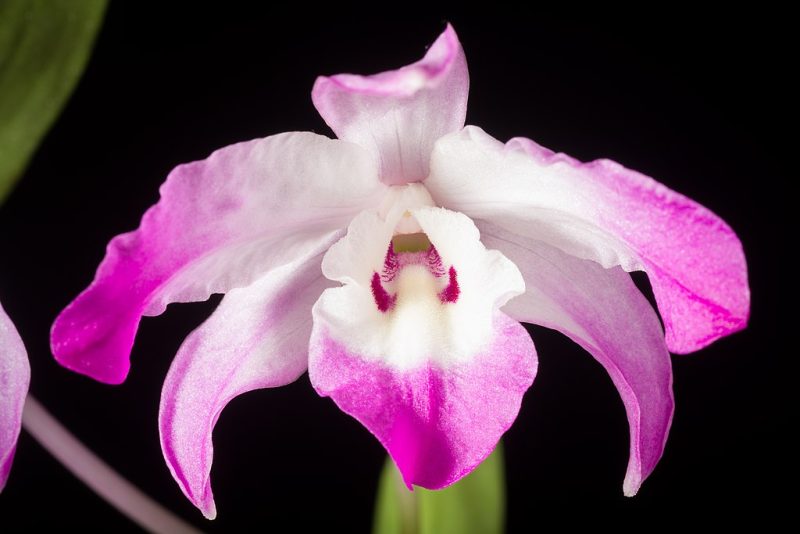
Regular pruning and maintenance are essential for keeping your Dendrobium orchids healthy and promoting vigorous growth.
Proper care ensures that your orchids will continue to produce stunning blooms year after year.
Guidelines for Pruning Spent Blooms
- After your Dendrobium orchid has finished blooming, you can prune the flower spike to encourage new growth. Use sterilized scissors or pruning shears to make a clean cut.
- Cut the flower spike near the base of the plant, but be careful not to damage the pseudobulbs or leaves.
- Removing spent blooms and flower spikes helps redirect the plant’s energy toward new growth and future blooms.
Maintaining Healthy Growth
- Regularly inspect your Dendrobium orchids for signs of pests or diseases. Early detection and treatment are key to preventing problems from spreading.
- Keep the leaves clean by gently wiping them with a damp cloth. This helps the plant photosynthesize more efficiently and reduces the risk of pest infestations.
Tips for Repotting and Managing Root Systems
- Dendrobium orchids should be repotted every 2-3 years or when the potting mix breaks down and becomes compacted. Fresh potting mix provides better aeration and drainage for the roots.
- When repotting, carefully remove the orchid from its pot and gently shake off the old potting mix. Trim any dead or rotting roots with sterilized scissors.
- Choose a pot that is slightly larger than the root ball, and use a well-draining orchid potting mix. Ensure the pot has drainage holes to prevent waterlogging.
- Position the orchid in the new pot and gently fill in around the roots with the potting mix. Firm the mix lightly to support the plant, but be careful not to compact it too much.
By following these guidelines for pruning, maintenance, and repotting, you can ensure that your Dendrobium orchids remain healthy and continue to thrive.
Common Pests and Problems in Dendrobium Orchids
Dendrobium orchids, like all plants, can be susceptible to pests and diseases. Early detection and appropriate treatment are crucial for maintaining the health of your orchids. Here are some common issues and preventative measures:
Identifying and Treating Common Issues
- Pests: Common pests include spider mites, scale insects, mealybugs, and aphids. These can usually be controlled with insecticidal soap or horticultural oil. In severe cases, a systemic insecticide may be necessary.
- Diseases: Orchids can be affected by fungal and bacterial diseases, such as root rot, leaf spot, and crown rot. Good hygiene and air circulation are key to prevention. Infected parts should be removed, and a fungicide or bactericide may be applied if needed.
- Environmental Stress: Yellowing leaves, wrinkled pseudobulbs, and bud drops can be signs of environmental stress, such as incorrect light, temperature, or humidity levels. Adjusting the growing conditions to better suit the needs of your orchid can often resolve these issues.
Preventative Measures
- Quarantine New Plants: Always quarantine new orchids for a few weeks to ensure they are free from pests and diseases before introducing them to your collection.
- Regular Inspections: Regularly inspect your orchids for signs of pests or diseases. Early detection is crucial for effective treatment.
- Good Hygiene: Keep your growing area clean and sterilize tools before use to prevent the spread of pests and diseases.
- Proper Watering: Avoid overwatering, as this can lead to root rot. Ensure that the potting mix is well-draining and that pots have adequate drainage holes.
- Air Circulation: Provide good air circulation around your orchids to reduce humidity and prevent fungal diseases.
By being vigilant and proactive in your care, you can prevent most pests and diseases from affecting your Dendrobium orchids.
If you do encounter any issues, address them promptly to keep your orchids healthy and thriving.
Dendrobium Orchid Varieties
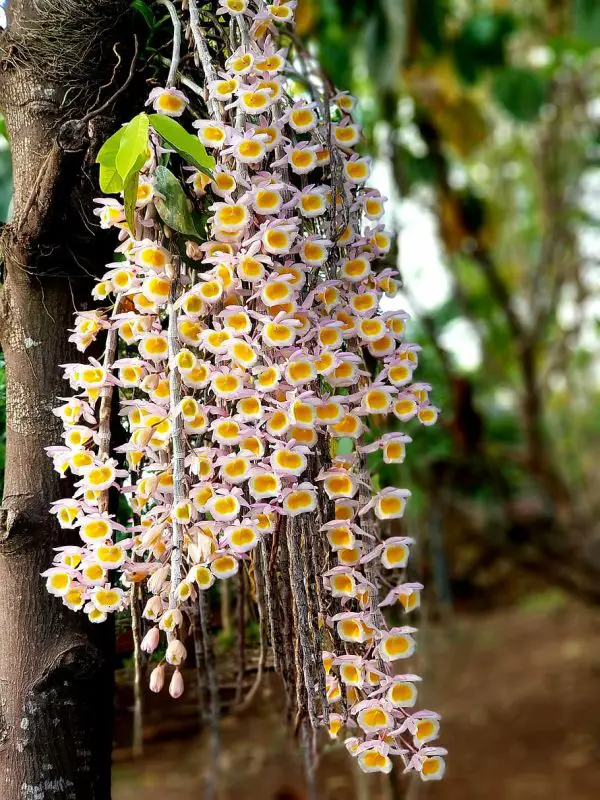
Dendrobium orchids boast an incredible diversity, with over 1,800 species and numerous hybrids. Each variety has its unique charm and specific care requirements. Let’s explore some popular and unique Dendrobium varieties:
Popular Dendrobium Varieties
- Dendrobium nobile: Known for its vibrant colors and sweet fragrance, this variety produces flowers along its cane-like pseudobulbs. It requires a cool rest period in winter to bloom.
- Dendrobium phalaenopsis: Resembling the blooms of a Phalaenopsis orchid, this variety is prized for its large, showy flowers and ease of care.
- Dendrobium kingianum (Pink Rock Orchid): A compact and hardy variety, it produces small, fragrant flowers in shades of pink and purple.
Unique Dendrobium Varieties
- Dendrobium spectabile: This variety is known for its unusual, alien-like flowers with twisted petals and sepals.
- Dendrobium anosmum (Hono Hono Orchid): It features long, cane-like pseudobulbs and produces fragrant, lavender-colored flowers.
- Dendrobium cuthbertsonii: A miniature variety with long-lasting, brightly colored flowers, ideal for small spaces.
Care Requirements
- Light: Most Dendrobiums prefer bright, indirect light. Some, like D. kingianum, can tolerate more direct sunlight.
- Water: Watering frequency depends on the variety. Generally, allow the potting mix to dry slightly between waterings.
- Temperature: Temperature requirements vary. For example, D. nobile needs cooler temperatures in winter to induce blooming, while D. phalaenopsis prefers consistently warm conditions.
- Humidity: Aim for 50-70% humidity. Some varieties, like D. spectabile, may require higher humidity levels.
Each Dendrobium variety has its own charm and specific needs. By understanding the characteristics and care requirements of different varieties, you can choose the ones that best suit your environment and enjoy their stunning beauty.
Propagating Dendrobium Orchids
Propagating Dendrobium orchids is a rewarding way to expand your collection and share these beautiful plants with friends and fellow enthusiasts.
Here are some common methods and tips for successful propagation:
Methods for Dividing and Propagating New Plants
- Keiki Propagation: Some Dendrobium species produce keikis (baby plants) on their canes. Once the keiki has developed several roots, it can be carefully removed and potted in its own container.
- Division: Mature Dendrobium orchids can be divided during repotting. Ensure that each division has at least three to four healthy pseudobulbs and a good root system.
Tips for Successful Propagation and Growth
- Potting Medium: Use a well-draining orchid potting mix for the new plants. A mix of bark, perlite, and charcoal is suitable for most Dendrobiums.
- Watering: Keep the potting medium slightly moist but not soggy. Overwatering can lead to root rot, especially in young plants.
- Light: Provide bright, indirect light for the newly potted plants. Avoid direct sunlight, which can damage the delicate leaves of young orchids.
- Temperature and Humidity: Maintain the appropriate temperature and humidity levels for the specific Dendrobium variety you are propagating.
- Fertilizing: Once the new plants are established, start feeding them with a diluted orchid fertilizer to support their growth.
By following these methods and tips, you can successfully propagate Dendrobium orchids and enjoy the process of growing these stunning plants from start to finish.
FAQ Section: Navigating Dendrobium Orchid Care
Caring for Dendrobium orchids can raise many questions, especially for new orchid enthusiasts.
This FAQ section aims to address common queries and provide expert tips to help you ensure vibrant blooms and healthy growth for your Dendrobium orchids.
Q: Where is the best place to put a Dendrobium orchid?
A: Place your Dendrobium orchid in a location with bright, indirect light, such as an east-facing windowsill. Avoid direct afternoon sunlight to prevent leaf burn.
Q: What do you do with Dendrobium orchids after they bloom?
A: After blooming, continue regular care, including watering, fertilizing, and providing adequate light. Do not cut the cane unless it’s completely dry, as it can still provide energy for future growth.
Q: Are Dendrobium orchids hard to care for?
A: Dendrobium orchids require specific care, but they are not necessarily hard to care for. With the right light, temperature, humidity, and watering routine, they can thrive and bloom beautifully.
Q: How do I get my Dendrobium orchid to rebloom?
A: Ensure your orchid is receiving adequate light, and maintain proper watering and fertilizing routines. Some Dendrobium species require a drop in temperature at night to trigger reblooming.
Q: How do you keep Dendrobium blooming?
A: Provide bright, indirect light, consistent watering, and regular fertilization. Ensure good air circulation and maintain proper humidity levels to support continuous blooming.
Q: How many times a year does Dendrobium bloom?
A: The frequency of blooming depends on the species and care conditions. Some Dendrobium orchids can bloom multiple times a year, while others may bloom once a year.
Q: Do you cut back Dendrobium orchids?
A: Generally, you should not cut back Dendrobium orchids unless the cane is completely dry and brown. Cutting back healthy canes can prevent future blooms.
Q: How do you make a Dendrobium flower?
A: To encourage flowering, provide bright, indirect light, maintain a consistent watering and fertilizing schedule, and ensure the orchid experiences a slight drop in temperature at night.
Q: Why is my Dendrobium orchid not flowering?
A: Common reasons for a Dendrobium not flowering include insufficient light, incorrect temperature, overwatering, or lack of nutrients. Addressing these issues can help promote blooming.
Conclusion: Embracing the Beauty of Dendrobium Orchids
Dendrobium orchids are a captivating addition to any plant collection, offering a stunning array of colors, shapes, and sizes.
By understanding their specific care needs, you can ensure these orchids thrive and continue to enchant with their beauty.
Learn more: Orchid Types: Discover an Astonishing Variety of Orchids
Recap of Key Care Tips for Thriving Dendrobium Orchids
- Light: Provide bright, indirect light, avoiding direct afternoon sun.
- Temperature: Maintain daytime temperatures of 65-75°F and cooler nights.
- Humidity: Aim for 50-70% humidity for optimal growth.
- Watering: Water weekly, allowing the potting mix to dry slightly between waterings.
- Potting: Choose the right pot and potting mix for good drainage and root health.
- Fertilizing: Regularly fertilize during the growing season with a balanced orchid fertilizer.
Encouragement to Explore the Diverse World of Dendrobium Orchids
We encourage you to dive into the diverse world of Dendrobium orchids.
Whether you’re drawn to the classic beauty of Dendrobium nobile or the unique charm of Dendrobium spectabile, there’s a variety to suit every taste.
Embrace the challenge of orchid care, and enjoy the rewards of nurturing these exquisite plants.
Find Dendrobium Orchids on Amazon
Resources for Dendrobium Orchid Care
Diving into the world of Dendrobium orchids can be an exciting journey, and having access to reliable resources can greatly enhance your understanding and success in caring for these beautiful plants.
Here are some authoritative websites that offer valuable information on Dendrobium orchid care:
- American Orchid Society (AOS): www.aos.org
- The AOS is a go-to resource for orchid care, offering detailed culture sheets, tips on growing various orchid genera, including Dendrobium, and advice on addressing common orchid problems.
- Royal Horticultural Society (RHS): www.rhs.org.uk
- The RHS provides expert guidance on orchid care, including information on different Dendrobium species and how to grow them successfully in various conditions.
- Smithsonian Gardens: gardens.si.edu
- Smithsonian Gardens offers orchid care sheets that cover the essentials of Dendrobium orchid care, from watering and lighting to temperature and humidity requirements.
By exploring these resources, you can deepen your knowledge of Dendrobium orchids and become a more informed and successful orchid grower.
Whether you’re a beginner or an experienced orchid enthusiast, these websites offer valuable insights into the captivating world of Dendrobium orchids.
This post contains affiliate links.

